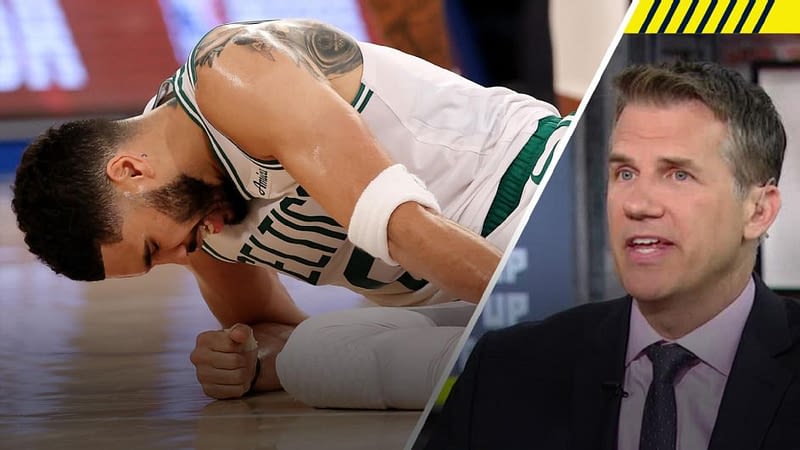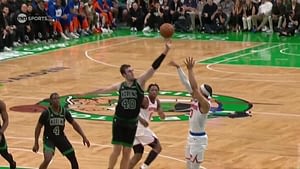Jayson Tatum’s Achilles Injury: A Devastating Blow to the Celtics and the NBA
In a moment that sent shockwaves through the NBA, testing on Tuesday confirmed the worst fears for the Boston Celtics and their fans. Jayson Tatum, the team’s leading scorer and a three-time All-NBA first team pick, suffered a rupture of his right Achilles tendon during Monday’s loss to the New York Knicks. This injury not only sidelines him for the remainder of the postseason but also puts his availability for the 2025-26 season in jeopardy.
Tatum’s injury is monumental, given his critical role in the Celtics’ success as the defending champions. The ramifications are significant, starting with Boston’s ability to overcome a 3-1 deficit against the Knicks, who are now favored in the series. But the impact extends far beyond this season, affecting how the Celtics will approach the next one.
Let’s delve into how Boston might cope without Tatum, the history of Achilles injuries in the NBA, and what this means for the Celtics moving forward.
When Might We See Tatum Return?
Historically, no NBA player since Jose Juan Barea in 2019 has returned sooner than 10½ months after an Achilles rupture. This suggests that the Celtics should plan on Tatum missing the entire 2025-26 regular season. While a postseason return is more realistic, there’s little precedent for such a comeback.
The only NBA player to return from a season-long injury in the playoffs was Larry Krystkowiak with the Milwaukee Bucks in 1991. He came back from an ACL repair to play three games, totaling just two points. Although Krystkowiak was a starter before the injury, the stakes weren’t as high as they are with an All-NBA first teamer like Tatum.
Postseason returns were considered for both Kevin Durant and Klay Thompson after their injuries in the 2019 NBA Finals, but neither materialized. The Golden State Warriors’ 2019-20 season ended before Thompson was cleared, and Durant opted not to join the Brooklyn Nets for the bubble restart in 2020, returning a year and a half after his Achilles rupture at the start of the 2020-21 campaign.
Based on this history, Boston might need to approach the 2025-26 season as if Tatum won’t play at all, even in the playoffs. This dramatically alters the outlook for a team that has won 15 playoff series since drafting Tatum No. 3 in 2018.
Second-Apron Squeeze
As ESPN’s Brian Windhorst recently detailed, the Celtics are entering a precarious financial situation. With Tatum’s supermax extension—the largest in NBA history to date, surpassing teammate Jaylen Brown’s—set to kick in next summer, Boston is more than $40 million over the 2025-26 luxury tax line. This doesn’t include veteran stalwart Al Horford, who will be an unrestricted free agent at age 39.
The looming tax bill for the Celtics, along with restrictions on teams that exceed the second luxury tax apron, was always going to force difficult decisions. Tatum’s injury accelerates these decisions. Paying well over $200 million in luxury taxes for a potential championship team is one thing; doing so for a team with uncertain prospects is another.
Age is another factor. If Boston’s next title window shifts from 2026 to 2027, it affects the thinking about veteran players, most notably Jrue Holiday. By the 2026-27 season, Holiday will be 36 years old. The Celtics might be better off trading Holiday to another contender while his value remains strong, reducing their payroll and getting younger on the perimeter at the cost of downgrading defensively.
Conversely, Tatum’s absence could prevent Boston from considering the nuclear option of trading Brown. The long-term financial challenge for the Celtics is having two players in Brown and Tatum who together make more than 60% of the salary cap through 2028-29. Maintaining the depth that has been a hallmark of the team will be challenging now that their two most important players are being paid like the stars they are.
In Tatum’s absence, Brown’s ability to create his own shots will become crucial. They were the only two Celtics rotation players to be assisted on less than 59% of their field goals this season—Tatum at 39% and Brown at 46%.
Expectations for Tatum
Durant’s return will undoubtedly be the benchmark for Tatum. Despite suffering his Achilles injury at 30, three years older than Tatum, Durant returned as the dominant force he was before the injury and remains an All-Star six years removed from it.
Durant’s example shows it’s possible to avoid a major loss of performance after an Achilles rupture. Perhaps the most likely impact for Tatum will be on his durability. Including the playoffs, no one has played more NBA games than Tatum since he was drafted, and this season’s eight games missed due to injury—six of them in March and April, with Boston coasting to the No. 2 seed—were a career high.
Whenever Tatum returns to the court, he’ll likely be limited from playing back-to-back games for a period and will probably have his minutes monitored. This could make it difficult for Tatum to add more All-NBA first-team appearances, even if his productivity doesn’t suffer.
Typically, multiskilled wings have performed the best coming back from Achilles injuries. Beyond Durant, this group includes Thompson and Wesley Matthews, who was back on the court less than eight months after his injury in 2015 and continued to play in the NBA through age 37.
There’s no guarantee Tatum will join that group, rather than more cautionary examples like DeMarcus Cousins and John Wall. But there’s also no reason to consider an Achilles rupture the end of Tatum’s ability to play at a high level.
How Can the Celtics Come Back in This Series?
First, they need to overcome the shock of seeing their star player helped to the locker room in a wheelchair. Tatum’s injury was disheartening, but his Boston teammates will have a couple of days to process it by the time the team tries to stay alive in Game 5 at home on Wednesday night.
Even before Tatum’s injury, the Celtics were in a huge hole after falling down 3-1 in the series. Historically, 3-1 comebacks have been much more feasible for the higher seed, as Boston is. Still, that means teams have rallied to win 8% of the time in best-of-seven series since 1984 (going 5-58), compared with just 1% of the time in series where the lower seed trails 3-1 (2-141).
Beyond that, Tatum was the biggest reason the Celtics were in Game 4 despite giving up 70 points in the second half. Tatum scored 42 points in 40 minutes, tying the most career 40-point playoff games for any Boston player, before going down.
In Tatum’s absence, the Celtics will need to rely on a defense that held the Knicks to a combined 184 points in Games 2 and 3. Keeping Jalen Brunson out of the paint should be the top priority. Brunson’s 18 points in the paint on Monday nearly matched his total of 22 over the first three games of the series.
As a team, New York had 64 points in the paint in Game 4, the third most by a team in any playoff game this season, according to NBA Advanced Stats. The Celtics could replace Tatum by putting more size on the court, protecting the rim at the expense of their own shooting. If Boston can get the Knicks’ offense back in the mud, there’s enough scoring for the Celtics to win three consecutive games and pull off an improbable comeback.
Nonetheless, the combination of losing the game and Tatum on Monday has taken Boston from having the best odds to win the Eastern Conference at ESPN BET entering Game 4 to last of the four remaining teams now.
Originally Written by: Kevin Pelton





















